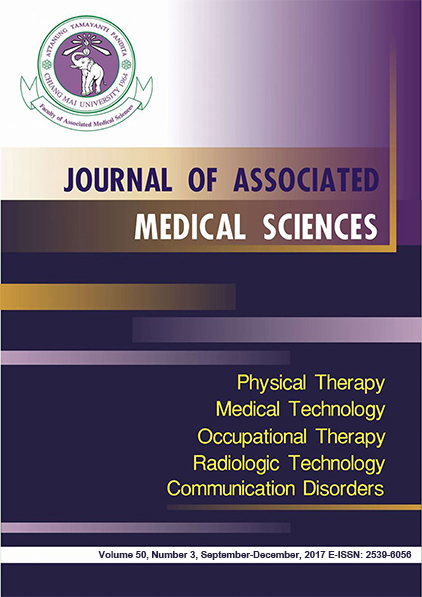Effect of smartphone location and walking speed on spatiotemporal gait parameters in older adults
Main Article Content
Abstract
Background: Cell phone use while walking has been linked with an increased number of accidental injuries. During old age, simple activities such as carrying a phone while walking may lead to gait modifications. However, no research has studied the effect of smartphone location on spatiotemporal gait parameters in older adults.
Objectives: To study the effect of carrying a smartphone in 5 different locations during walking at self-selected comfortable, fast, and slow speeds on spatiotemporal gait parameters in older adults.
Materials and methods: Twenty-two older adults (age 73.91±5.62 years) were asked to walk at self-selected comfortable, fast, and slow speeds over a 10-meter walkway, with the GAITRite electronic walkway placed in the middle of this path. During all walking trials, participants carried a smartphone in one of five locations: 1) in the right hand, held in a telephone speaking position (hand); 2) in the front right pant pocket (pocket); 3) on a belt attached above the front right pant pocket (belt); 4) in a shoulder bag (bag); and 5) attached to the body above the third lumbar vertebrae (body). A two-way repeated measure ANOVA was used to determine the effect of smartphone location and gait speed. The p value was set at p≤0.05.
Results: No significant interaction effect was found for any spatiotemporal gait parameters. However, there was a significant main effect of smartphone location on the step length and gait speed. Specifically, when carrying a smartphone in the pocket, older adults walk with shorter step length (p=0.031) compared to the body location, and slower gait velocity compared to the bag and body locations (p=0.025 and 0.011, respectively).
Conclusion: Location of smartphone affects the way older adults walk. When carrying a smartphone in the pocket, it is possible that the older adults choose a more conservative gait strategy by walking slower with a shorter step length.
Article Details
Personal views expressed by the contributors in their articles are not necessarily those of the Journal of Associated Medical Sciences, Faculty of Associated Medical Sciences, Chiang Mai University.
References
2. Electronic Transactions Development Agency (Public Organization) Ministry of Information and Communication Technology. Thailand Internet user profile 2016 [Internet]. 2016 Aug .[cited 2017 Jul 30]; 2016: 48-56. Available from: https://www.etda.or.th/publishing-detail/thailand-internet-user-profile-2016-th.html
3. Young KL, Rudin-Brown CM, Patten C, Ceci R, Lenné MG. Effects of phone type on driving and eye glance behaviour while text-messaging. Safety Sci 2014; 68: 47-54. doi:10.1016/j.ssci.2014.02.018.
4. Thomee S, Harenstam A, Hagberg M. Mobile phone use and stress, sleep disturbances, and symptoms of depression among young adults-a prospective cohort study. BMC Public Health 2011; 11: 66. doi:10.1186/1471-2458-11-66.
5. Nasar JL, Troyer D. Pedestrian injuries due to mobile phone use in public places. Accid Anal Prev 2013; 57: 91-5. doi: http://dx.doi.org/10.1016/j.aap.2013.03.021.
6. Schwebel DC, Stavrinos D, Byington KW, Davis T, O’Neal EE, de Jong D. Distraction and pedestrian safety: how talking on the phone, texting, and listening to music impact crossing the street. Accid Anal Prev 2012; 45: 266-71. doi:10.1016/j.aap.2011.07.011.
7. Lamberg EM, Muratori LM. Cell phones change the way we walk. Gait Posture 2012; 35: 688-90. doi:10.1016/j.gaitpost.2011.12.005.
8. Kao PC, Higginson CI, Seymour K, Kamerdze M, Higginson JS. Walking stability during cell phone use in healthy adults. Gait Posture 2015; 41: 947-53. doi: http://dx.doi.org/10.1016/j.gaitpost.2015.03.347.
9. Dreyfuss D, Elbaz A, Mor A, Segal G, Calif E. The effect of upper limb casting on gait pattern. Int J Rehabil Res 2016; 39: 176-80. doi: 10.1016/j.clinph.2015.06.005.
10. Aguiar L, Santos-Rocha R, Vieira F, Branco M, Andrade C, Veloso A. Comparison between overweight due to pregnancy and due to added weight to simulate body mass distribution in pregnancy. Gait Posture 2015; 42: 511-7. doi: 10.1242/jeb.026153.
11. Cui Y, Chipchase J, Ichikawa F. A Cross Culture Study on Phone Carrying and Physical Personalization. In: Aykin N, editor. Usability and Internationalization HCI and Culture. Berlin, Heidelberg: Springer 2007.
12. Kang HG, Dingwell JB. Effects of walking speed, strength and range of motion on gait stability in healthy older adults. J Biomech 2008; 41: 2899-905. doi:10.1016/j.jbiomech.2008.08.002.
13. Arellano CJ, O’Connor DP, Layne C, Kurz MJ. The independent effect of added mass on the stability of the sagittal plane leg kinematics during steady-state human walking. J Exp Biol 2009; 212: 1965-70. doi:10.1242/jeb.026153.
14. Ortega JD, Fehlman LA, Farley CT. Effects of aging and arm swing on the metabolic cost of stability in human walking. J Biomech 2008; 41: 3303-8. doi:10.1016/j.jbiomech.2008.06.039.


